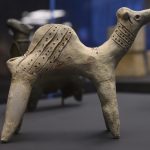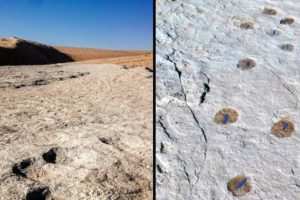
A 70-million-year-old nest filled with the remains of baby Protoceratops gives clues to the dinos’ early behavior.
A 70-million-year-old nest of the dinosaur Protoceratops andrewsi has been found with evidence that 15 juveniles were once inside it, according to a paper in the latest Journal of Paleontology.
While large numbers of eggs have been associated with other dinosaurs, such as the meat-eating Oviraptor or certain duck-billed hadrosaurs, finding multiple juveniles in the same dino nest is quite rare.
I, for one, cannot think of another dinosaur specimen that preserves 15 juveniles at its nest in this way,” lead author David Fastovsky told Discovery News.
Fastovsky, who is chair of the University of Rhode Island’s Department of Geosciences, and his colleagues analyzed the dinosaur remains along with the nest, which measured about 2.3 feet in diameter and was round and bowl-shaped. All were found at Djadochta Formation, Tugrikinshire, Mongolia, where it’s believed sand “rapidly overwhelmed and entombed” the youngsters while they were still alive.
The researchers conclude that the 15 dinosaurs all show juvenile characteristics. These include short snouts, proportionately large eyes, and an absence of adult characteristics, such as the prominent horns and large frills associated with adults of this species. At least 10 of the 15 fossil sets are complete.
The nest and its contents imply that Protoceratops juveniles remained and grew in their nest during at least the early stages of postnatal development. The nest further implies that parental care was provided.
The large number of offspring, however, also suggests that juvenile dinosaur mortality was high, not only from predation, but also from a potentially stressful environment.
“Large clutches may have been a way of ensuring survival of the animals in that setting — even if there was extensive parental care,” Fastovsky said. “Mongolia was, at the time, a place with a variety of theropod dinosaurs, some of whom likely ate babies such as these.”
“The most obvious of these, found in the same deposits, is the (in)famous Velociraptor, a smallish nasty theropod with bad breath, for whom babies such as these would have made a nice bon bon,” he continued.
Yet another discovery previously found at the same locality is the famous “fighting dinosaurs” specimen in which a Protoceratops and Velociraptor appear to have been preserved together “locked in what was evidently mortal combat,” Fastovsky added. Parents and other adults of the sheep-sized herbivorous species may then have spent much of their time fighting off such hungry predators.
In a separate study, Lars Schmitz of the UC Davis Department of Evolution and Ecology, and colleagues studied bones surrounding what would have been the eyes of Protoceratops and other dinosaurs. The results allowed Schmitz and his team to conclude that this dinosaur and additional plant eaters were active both day and night. Velociraptor, on the other hand, was primarily a nocturnal carnivore, so night raids on Protoceratops nests must have taken place during the Late Cretaceous.
Even if the juvenile dinosaurs and their parents “had a good sensory system to notice a predator closing in, the success rate of a nocturnal attack may be higher than a diurnal attack,” Schmitz told Discovery News.
Given the chances then of literally biting the (sand) dust or becoming dinner, it’s no wonder that some small dinosaurs had so many kids.
“This story certainly isn’t your parents’ dinosaurs-living-in-the-lush-Cretaceous-steaming-jungles that was in vogue a generation or two ago,” Fastovsky said. “We now know that dinosaurs lived everywhere and did just about everything terrestrial.”
The nest and its dinosaur family contents are currently housed at the Paleontological Center of the Mongolian Academy of Sciences, Ulan Baatar, Mongolia.
By Jennifer Viegas
Wed Nov 16, 2011
Discovery















Hi, I do believe this is an excellent blog. I stumbledupon it 😉 I will come back
yet again since I book marked it. Money and freedom is the greatest way to change, may you be rich and continue to guide other people.
hi!,I love your writing so so much! percentage we keep up a correspondence extra about your post on AOL?
I require an expert on this area to unravel my problem.
Maybe that’s you! Taking a look forward to peer you.
you are truly a just right webmaster. The website loading speed is amazing.
It kind of feels that you’re doing any unique trick. In addition, The contents are masterwork.
you have done a wonderful activity in this matter!